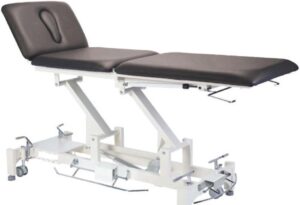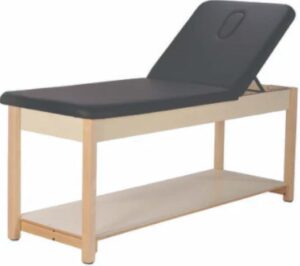Physical Therapy Treatment Tables – What’s the Difference?
When comparing a Hi-Lo table to a wood treatment table for physical therapy, several factors need to be considered, including functionality, adjustability, durability, comfort, and cost. Here’s a detailed comparison and contrast of the two:
Hi-Lo Table
 Functionality and Adjustability:
Functionality and Adjustability:
- Adjustable Height: Hi-Lo tables are designed with motorized or hydraulic systems that allow easy height adjustment. This is crucial for physical therapists to modify the table height according to different treatment needs and patient comfort.
- Versatility: Often equipped with multiple adjustable sections, allowing for various positions and treatment techniques.
Durability and Material:
- Construction: Typically made from metal frames (often steel or aluminum) for enhanced durability. The top surface is usually padded and covered with a durable, easy-to-clean material like vinyl.
- Longevity: Built to withstand frequent use in a clinical setting, with high weight capacities and robust mechanisms.
Comfort:
- Padding: Thick, high-density foam padding provides comfort for patients during treatments.
- Ergonomics: The ability to adjust the table to different heights and positions helps in maintaining ergonomic postures for both patients and therapists.
Cost:
- Higher Initial Investment: Generally more expensive due to the advanced features and materials used. The cost can vary widely depending on the model and features.
Wood Treatment Table
 Functionality and Adjustability:
Functionality and Adjustability:
- Fixed Height: Usually has a fixed height, which can be a limitation as it requires therapists to adjust their working posture or use additional tools like step stools.
- Basic Adjustability: Some models may have adjustable backrests, but they lack the comprehensive adjustability of Hi-Lo tables.
Durability and Material:
- Construction: Made from hardwood or other sturdy wood types. While durable, they may not withstand as much weight or wear and tear as metal-framed tables.
- Maintenance: Wood requires regular maintenance to prevent damage from moisture and wear.
Comfort:
- Padding: Typically includes some padding, but it may not be as thick or comfortable as that on Hi-Lo tables. The type of padding and covering material can vary.
- Ergonomics: Limited adjustability can affect the comfort of both patients and therapists, especially during prolonged treatments.
Cost:
- Lower Initial Investment: Generally more affordable than Hi-Lo tables. Prices can vary based on the type of wood and craftsmanship.
Summary
Hi-Lo Table:
- Pros: Highly adjustable, versatile, durable, comfortable, and ergonomically friendly.
- Cons: Higher initial cost and potential maintenance for the motorized/hydraulic components.
Wood Treatment Table:
- Pros: Lower cost, sturdy, aesthetically pleasing, and can be sufficient for basic treatments.
- Cons: Limited adjustability, potentially less comfortable, and requires more maintenance.
The choice between a Hi-Lo table and a wood treatment table depends on the specific needs of the physical therapy practice, the types of treatments provided, and budget considerations. Hi-Lo tables are ideal for practices requiring frequent adjustments and diverse treatment techniques, while wood treatment tables can suffice for more basic or static treatment needs.
If you have questions about which table is right for you, want to ask some questions, or just need some advice on how to proceed, contact GM Therapy Solutions – we love to help!
